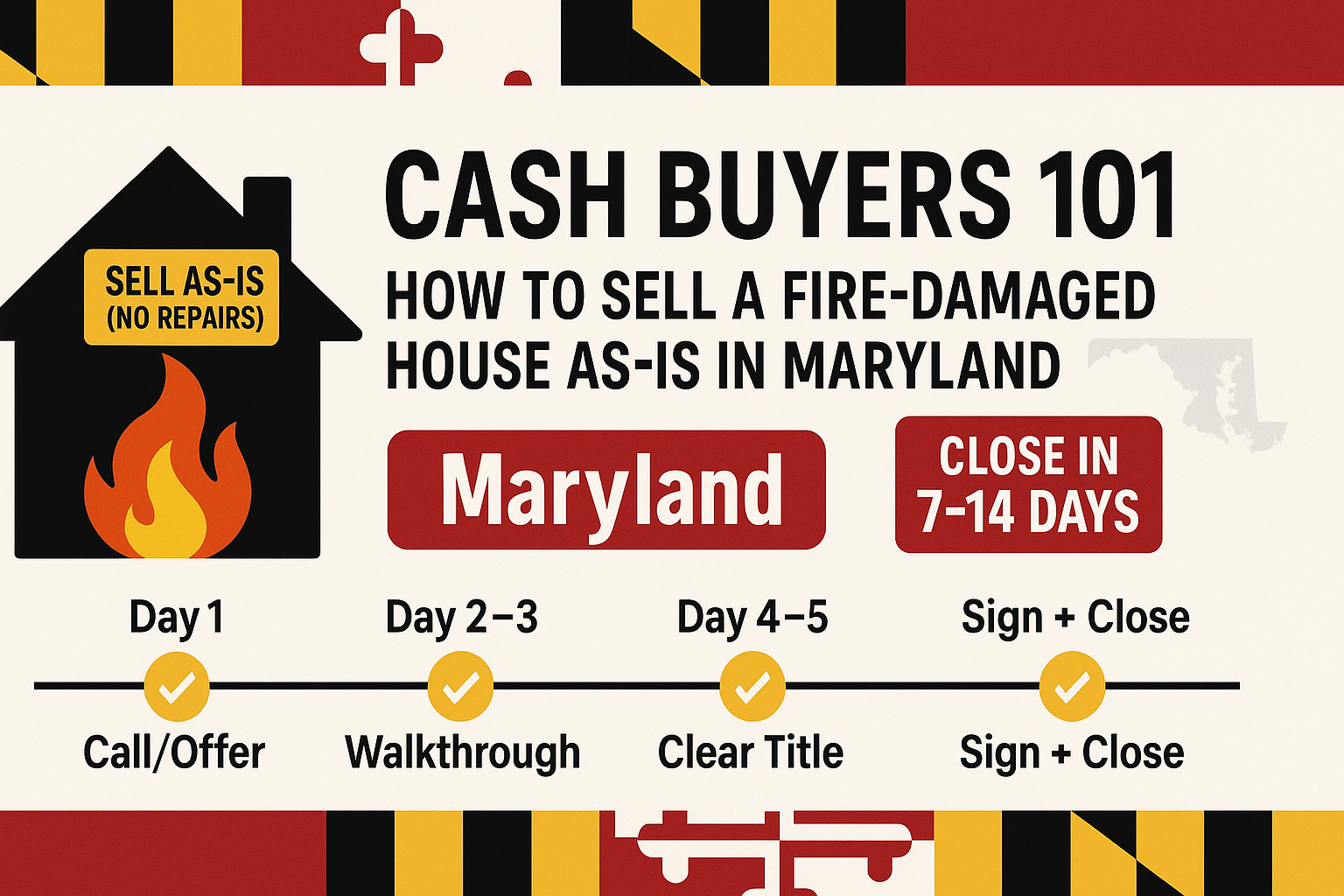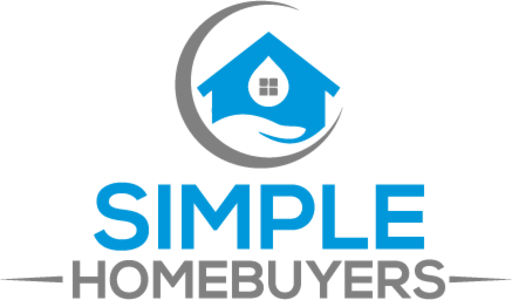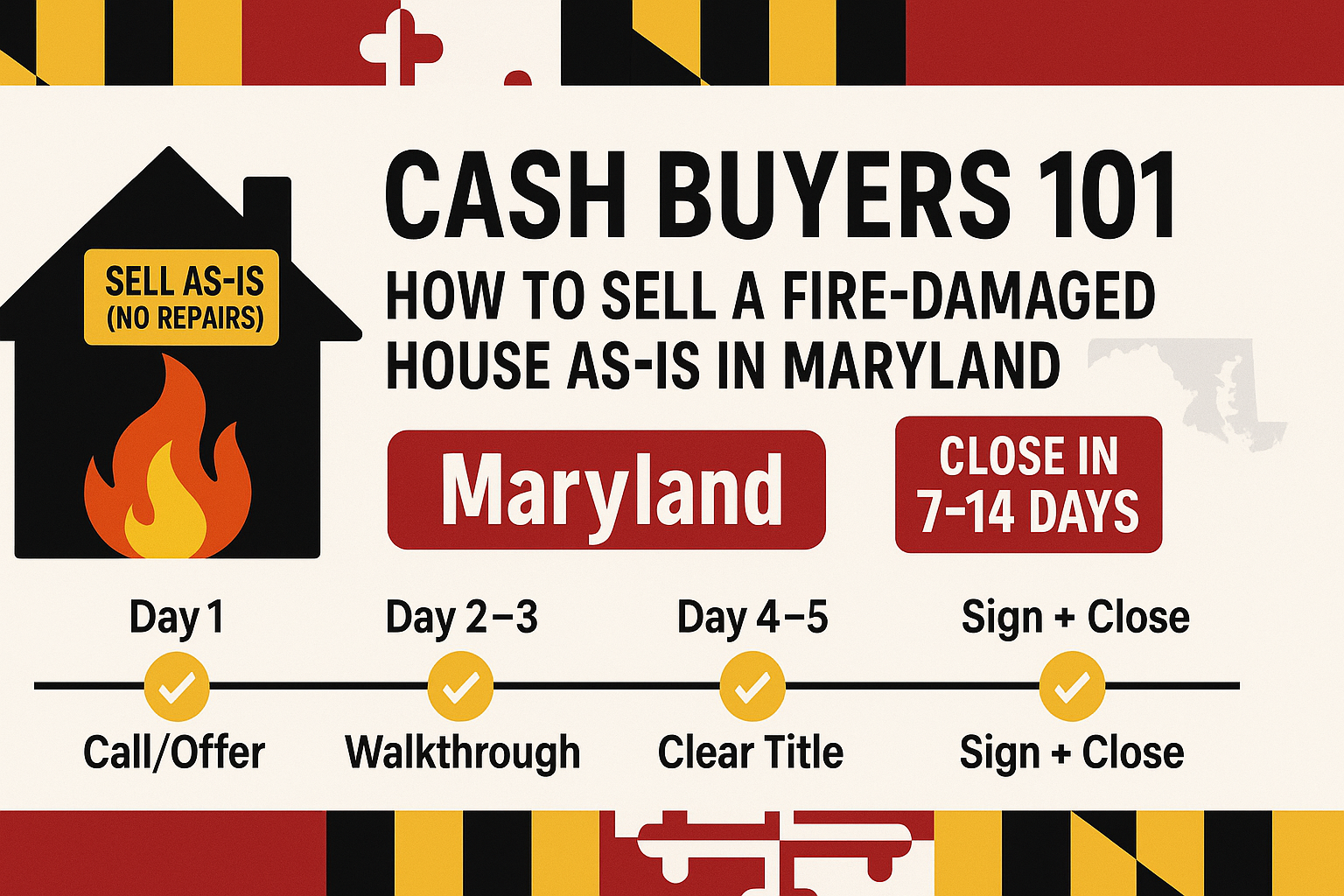
You’re here because you need a fast, safe, and realistic way to sell a fire‑damaged house in Maryland without spending months juggling contractors, inspections, and financing drama. You want honest math (not just “top price”), you want to know what “as‑is” really means in Maryland, and you want a walkthrough of insurance cash flow, safety prep, and paperwork that helps a cash buyer feel confident enough to close quickly. You’re also looking for credible sources—the actual Maryland statute and forms, the Maryland Insurance Administration (MIA) on ACV vs. RCV, federal guidance on lead‑safe work and post‑fire safety, plus county pages that explain permits and inspections. That’s exactly what this guide delivers, while keeping the focus where it should be: speed + certainty + net‑after‑time.
Why Cash Buyers Make Sense for Fire‑Damaged Homes in Maryland (Speed & Certainty)
Selling a fire‑damaged house in Maryland goes smoother when you design your process around speed and certainty—not just sticker price. Cash buyers remove the underwriting and appraisal bottlenecks that stall financed deals, so your timeline compresses to what title, payoffs, HOA/condo docs, and a brief inspection window require. When your goal is to convert a complex property into cash, the question isn’t “What’s the highest price someone might pay after I fix everything?” but “What’s my best net, fastest, with the fewest points of failure?”
Cash buyers in Maryland will still expect transparency. That’s great news for you because transparency is your leverage: a clean disclosure packet (more below), a short, well‑defined access window, and a clear path to closing make it easy for a serious cash buyer to commit. In practice, most owners trade a little sticker price for days or weeks saved, risk avoided, and carrying costs eliminated—which often produces the stronger net‑per‑day outcome.
When cash wins outright:
- The home has structural, electrical, or HVAC impacts from the fire.
- The property is older (pre‑1978), likely triggering lead‑safe work if you open walls.
- Your timeline is tight (estate, probate, vacancy, relocation).
- Your insurance RCV holdback is modest relative to the repair scope (details below).
What “As‑Is” Really Means Under Maryland Law (and Why It Helps You Close Faster)
Selling a fire‑damaged house as‑is in Maryland does not mean “say nothing.” Maryland’s Residential Property Disclosure/Disclaimer framework—set out in the Maryland Real Property §10‑702 seller disclosure law—requires you to deliver the state disclosure/disclaimer statement and to disclose known latent defects (hidden issues affecting health or safety) even on an as‑is contract. Use the official Maryland Residential Property Disclosure & Disclaimer Statement (PDF) and have the buyer acknowledge receipt with the contract; late delivery can create rescission rights and delay your deal.
Why this actually helps you: full, early disclosure reduces a cash buyer’s risk discount. If you attach the state form, a short narrative of what happened and where, any county damage inspection or permit cards you have, plus safety steps you’ve taken, a good investor won’t have to price for mystery. And the fewer unknowns, the more confident (and competitive) the offers.
Practical prep checklist for as‑is sales:
- Deliver the state Disclosure/Disclaimer with your first offer packet using the official PDF form.
- Summarize date/area of fire and areas touched (framing, wiring, HVAC, roof, insulation).
- If you stabilized hazards or changed smoke alarms, say so.
- Attach photos, estimates, permits/approvals, and any county inspection report.
Insurance Cash Flow: ACV vs. RCV, Holdbacks, and Your Decision Point
Insurance cash flow drives your decision more than most sellers realize. Most policies pay in two stages: Actual Cash Value (ACV) first (replacement cost minus depreciation), and then the recoverable depreciation once qualifying repairs are completed—known as Replacement Cost Value (RCV). The Maryland Insurance Administration explains this clearly in its Homeowners Insurance Guide and its Post‑Disaster Claims Guide. If you sell as‑is without completing repairs, you may forfeit part or all of the RCV holdback, so put that number in your net‑sheet. If you repair first, expect to front costs or use contractor financing while you wait for the holdback to release after work is documented and inspected.
Two tips to protect your net:
- Ask your adjuster/agent to spell out your RCV deadline and documentation requirements in writing (photos, invoices, permits, lien waivers).
- Prevent further loss (board‑up/tarp, safe utilities) and keep receipts—MIA’s Post‑Disaster Claims Guide notes this is expected and helps your claim.
If your holdback is small compared with the time, code upgrades, and carrying costs you’re staring at, as‑is usually wins on net‑after‑time. If the holdback is large and your scope is contained, finishing repairs before sale can make sense.
For the full head‑to‑head of every path (repairs vs. as‑is vs. listing), see our page: How to Sell a Fire‑Damaged House in Maryland.
Health & Safety Prep That Helps You Sell As‑Is (and Protects Everyone)
Safety preparation makes showings smoother and shortens diligence. The U.S. Fire Administration’s handbook After the Fire (PDF) is a practical, plain‑English checklist for re‑entry, utilities, and immediate cleanup after a fire. Use it to ensure safe access for buyers, contractors, and the title company’s appraiser if needed. If your home was built before 1978, any work disturbing paint should follow lead‑safe practices under the EPA Lead Renovation, Repair and Painting (RRP) program—which also reassures buyers you haven’t created new hazards during stabilization or partial repairs.
What to do right now:
- Confirm utilities are safe or capped; post a note at the panel/gas meter.
- HEPA vacuum and damp‑wipe heavy soot areas; avoid dry sweeping that re‑suspends particles.
- Change HVAC filters; if ducts were exposed to smoke, note any cleaning.
- Replace smoke/CO alarms as needed and mention compliance in your packet.
- Provide clear, safe paths for showings and a short, scheduled access window for the buyer’s inspector.
Buyer Types You’ll See: 203(k) Rehab Buyers vs. Cash Investors
Owner‑occupants sometimes try to buy a damaged home with FHA 203(k) financing, which wraps purchase + rehab into one loan. That can work for them—but it adds escrow draws, consultant reviews, and multiple inspections that slow your closing. The official HUD 203(k) Rehabilitation Mortgage Insurance Program page explains how funds are held and released, and the Maryland Mortgage Program: FHA Limited 203(k) shows the Limited version’s caps and mechanics. If your priority is speed and certainty, cash investors remain the simplest path to closing.
Cash buyers buy property in as‑is condition routinely; they price for risk and time but skip lender delays. When you give them a clear disclosure packet and a short, well‑organized inspection window, they can commit quickly because they already assume they’ll deal with permits, code, and environmental compliance after closing.
County Reality Check: Permits and Inspections Still Shape Value (Even As‑Is)
Permits and inspections still matter in an as‑is sale—because they influence the buyer’s perceived risk. In Montgomery County, the Restore/Repair permit process details application, fee payment, plan submission, and inspection steps when you reconstruct or replace damaged parts of a building. In Prince George’s County, owners can request a Damaged Property Inspection & Report and use the Emergency Repair Authorization process to stabilize hazards fast; inspectors aim to reach out within five business days after a damage‑inspection request. If you’re in Baltimore City, the Permit Handbook (PDF) and Permits portal outline the work that needs permits.
Even if you aren’t repairing, having (or referencing) these documents in your packet lowers buyer uncertainty and helps you negotiate less of a discount.
What to include in your packet if you interacted with the county:
- Permit numbers, inspection approvals, or permit cards (photos are fine).
- Any county damage report or inspection notes.
- A one‑paragraph summary of what is repaired, what isn’t, and any safety stabilization done.
Pricing for Net‑Per‑Day (A Simple Maryland Example You Can Copy)
Pricing a fire‑damaged house in Maryland isn’t about headlines; it’s about what you keep and how soon you get it. Use this simple framework with your own numbers:
Scenario A — Repair & List (Financed Buyer)
- Estimated restoration & rebuild: $45,000
- Contingency (15%): $6,750
- Carrying (4 months @ $2,000): $8,000
- Permits/fees/staging/misc.: $5,000
- List at $475,000 → Contract at $470,000
- Commission (example 5.1%): $23,970
- Maryland state transfer tax (0.5%): $2,350 (+ local recordation/transfer)
- Title/settlement/HOA & typical credits: $4,000
Estimated net before payoff: ~$374,000–$380,000 (depends on local taxes/credits)
Scenario B — As‑Is Cash
- No repairs: $0
- Carrying (2 weeks): $600
- Title/settlement: $2,500
- Contract price (condition‑adjusted): $440,000
- Commission: $0 (direct) or minimal if limited‑service
- Transfer/recordation: negotiated per county
Estimated net before payoff: ~$437,000–$439,000
Net‑per‑day reality: Even with a lower sticker price, as‑is cash can deliver tens of thousands more in net because you’ve removed months of burn and downgrade risk. Use Maryland’s official tax rules for accuracy when you build your net sheet, and keep in mind the disclosure and timing requirements in §10‑702 so you don’t create rescission windows.
How to Vet a Serious Cash Buyer (and Avoid Last‑Minute Surprises)
Proof of funds first. Ask for a recent bank statement or verification letter on institutional letterhead (you can redact account numbers).
Short inspection window. Two to five business days is typical for investors who know what they’re doing; “open‑ended” windows invite delays.
Clear title process. Pick a Maryland title company; order payoff statements and HOA/condo resale documents immediately.
No endless assignments. If the contract is assignable, cap it or require your written consent so you don’t get stuck re‑marketing the deal.
Meaningful earnest money. A real buyer is comfortable posting modest non‑refundable earnest money after the inspection period, applied to closing.
Written timeline. Lock in target dates for inspection, title clear, and settlement, with one built‑in extension everyone agrees to (e.g., 3–5 days).
These aren’t “hardball” tactics—they’re normal investor‑grade hygiene that keeps your closing on the rails.
The Exact Disclosure Packet That Helps You Win Negotiations
Create one PDF (or a cloud folder) labeled “123 Main St – Seller Disclosures (Fire)” and add:
- State Disclosure/Disclaimer form (signed) using the Maryland Residential Property Disclosure & Disclaimer Statement.
- A short incident narrative (date, rooms affected, known system impacts).
- Photos: immediately post‑fire, post‑cleanup, and current.
- County paperwork: Restore/Repair permit process status page or permit card, and any Damaged Property Inspection & Report you requested.
- Safety: summary of smoke/CO alarm compliance; if you replaced alarms, state brand/date and reference Maryland updates.
- Insurance: first page of the adjuster’s estimate (numbers redacted if you prefer), highlighting known structural/electrical items.
This is the packet that makes a buyer say, “We can move.” It eliminates mystery and supports a shorter inspection window and a firmer price.
Frequently Asked Questions (Maryland‑Specific)
Can I really sell a fire‑damaged home as‑is in Maryland?
Yes—as‑is sales are allowed, but you must still deliver the state disclosure/disclaimer and disclose known latent defects under the Maryland Real Property §10‑702 seller disclosure law.
Will a rehab loan (FHA 203(k)) make my timeline faster?
Not usually. HUD’s 203(k) program bundles purchase + rehab but adds escrows, consultant oversight, and multiple inspections. If you value speed, a vetted cash offer is typically faster. For Maryland’s Limited 203(k) specifics, see Maryland Mortgage Program: FHA Limited 203(k).
Do I need to worry about lead‑safe rules?
If the home is pre‑1978 and you (or a buyer) plan to disturb paint during repairs, lead‑safe practices apply under the EPA RRP program. Mentioning that you’ve followed (or planned for) RRP lowers buyer concern.
What safety steps should I take before showings?
Follow the USFA “After the Fire” guide for safe re‑entry, utilities, and cleanup. Replace smoke/CO alarms where required and keep walkways clear.
Where do county inspections fit in if I’m not repairing?
A county damage inspection or a permit card for any stabilization work still helps your buyer underwrite the risk. See Restore/Repair permit process (Montgomery) and Damaged Property Inspection & Report (Prince George’s), plus Baltimore City permits.
The Bottom Line (and Your Next Click)
Selling a fire‑damaged house in Maryland for cash works because it aligns the process with your goals: speed, certainty, and net‑after‑time. When your property faces code triggers, lead‑safe rules, and insurance holdback timing, the path that removes months of burn and risk is often the one that leaves you with more money in your pocket sooner—even if the sticker price is lower.
If your situation calls for a clean, quick exit, package your disclosures, offer a short access window, and request proof of funds. If you’re still on the fence, compare your paths in detail here: How to Sell a Fire‑Damaged House in Maryland.

